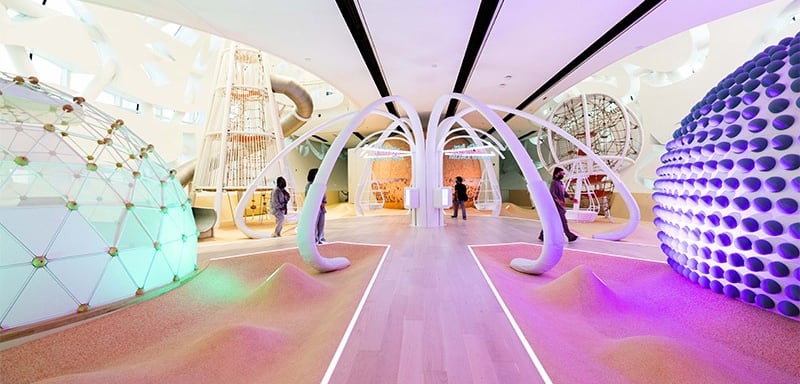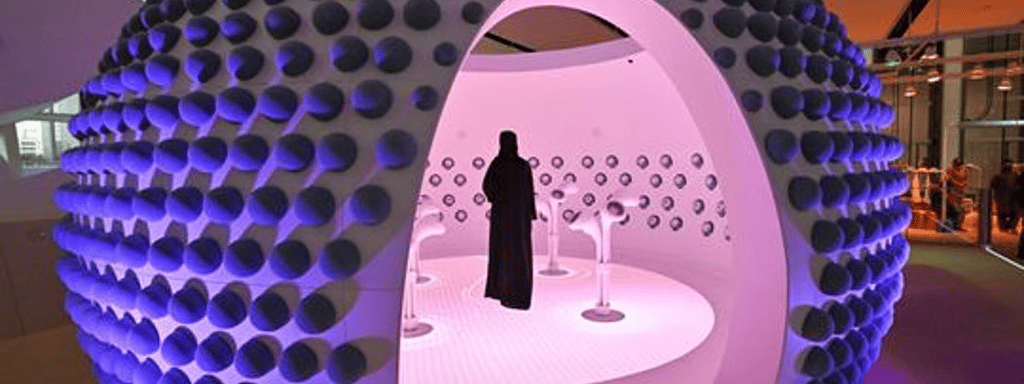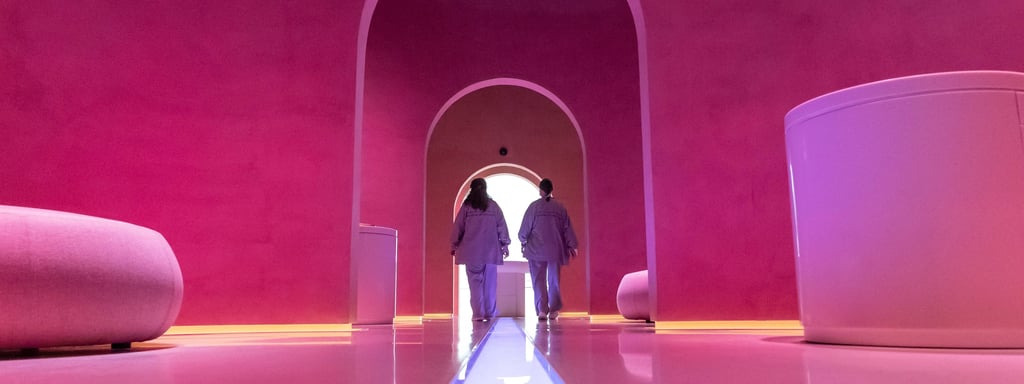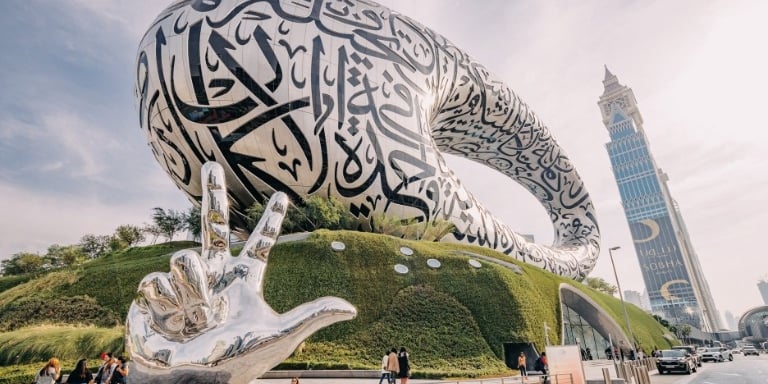Museum of the Future
Amazing architectural icon, immersive future‑tech experiences, and hands‑on inspiration rolled into one.


The Crescent of Possibility
Rising along Sheikh Zayed Road, the Museum of the Future is not just another Dubai landmark—it is a bold statement of ambition. Designed as a torus with a central void, the building symbolizes humanity's boundless curiosity and the mysteries of the unknown. At 77 metres tall and covering over 30,000 square meters, it floats above a green hill, grounded by the earth yet reaching for the stars.
Its shimmering stainless steel skin is etched with Arabic calligraphy—quotes about innovation, creativity, and legacy. These luminous scripts are not mere ornament; they serve as windows, bathing the interior in natural light filtered through poetry. This building is not just seen—it is read, heard, and felt.
Each panel of the exterior was individually crafted using robotic fabrication, forming a parametric masterpiece that merges advanced engineering with lyrical expression. The façade curves and flows like a living entity, a testament to both technological prowess and artistic grace.
Stubborn Steel, Silently Speaking
The museum’s elliptical form is held aloft by a diagrid steel frame, a structure free of internal columns, allowing for open, fluid spaces inside. Its very construction challenges traditional limits of architecture. What might have seemed impossible on paper now stands as one of the most complex and innovative buildings in the world.
The calligraphy, stretching thousands of meters across the surface, glows at night, transforming the museum into a floating lantern of ideas. These phrases, written by hand and then adapted for the façade, invite every visitor to reflect on their role in shaping the future.


A Time‑Bound Descent
Visitors enter at the top and descend floor by floor through distinct thematic realms, each one representing a stage in our collective journey toward tomorrow.
At the summit lies OSS Hope—a simulated space station orbiting 600 kilometers above Earth. Here, visitors explore what life might be like in orbit: navigating zero-gravity habitats, analyzing asteroid mining missions, and observing the Earth from afar. This is not science fiction—it is speculative science made tactile.
Descending brings you into the HEAL Institute, where the Earth’s biosphere is displayed as a vast, data-driven ecosystem. Inside a digital rainforest under glass, endangered species flicker into life, their genetic codes preserved in a DNA library. This is a space for restoration, healing, and ecological imagination.
Next is Al Waha, the Oasis. A hushed realm of sensory therapy and self-awareness, this floor emphasizes emotional well-being through meditative soundscapes, electromagnetic resonance, and tactile exploration. In a world of constant noise, Al Waha whispers the value of silence.
On the floor titled Tomorrow Today, the near future is brought into focus. Here, visitors interact with real technologies already reshaping our world—robotics, renewable energy systems, AI-driven medicine, and food innovation. This is a place of prototypes and possibilities, where today’s disruptions become tomorrow’s norms.
Finally, at the heart of the museum lies Future Heroes, a space designed for children. Through storytelling, avatar creation, and interactive missions, young minds learn the values of collaboration, imagination, and resilience. The future, after all, is not only about technology—it is about people.
Living Museum: Always Becoming
Unlike traditional institutions, the Museum of the Future is a living organism. Its exhibits are not fixed—they adapt, evolve, and respond to global events and technological shifts. Here, learning is not passive. It is participatory.
From artificial intelligence to climate solutions, from virtual reality to biotechnology, the topics explored are fluid. The museum hosts ongoing exhibitions, speaker forums, innovation labs, and think tanks. It invites not only experts but dreamers, creators, and students to contribute to an ever-growing conversation.
Temporary exhibits and rotating installations ensure that each visit reveals something new. It is a museum in motion, mirroring the very essence of the future: change.


Green Thinking for Blue Skies
Sustainability lies at the core of the building’s philosophy. From its earliest design phases, the museum was envisioned as a model of environmental responsibility. It is one of the few museums globally to achieve top-level green certifications.
Its vegetated podium reduces urban heat, while advanced climate control systems reduce energy consumption. Recycled materials, water-saving technologies, and passive solar design make the museum not just a showcase of sustainable futures, but an example of one.
Architecture here is not merely shelter—it is a moral act, a gesture of care for the planet it occupies.
The Whisper of Innovation
Every detail of the interior speaks to tomorrow. Visitors are guided by robotic hosts, served coffee by a robot barista, and moved between galleries by panoramic elevators that feel like sci-fi set pieces. Even the elevators themselves are part of the show—transparent pods that reveal the museum’s vertical spine, glowing with LED light.
Interactive touchscreens respond not just to touch but to emotion and gesture. Biometric feedback adapts certain experiences to your responses. You are not just a visitor—you are a participant.
In this environment, learning becomes embodied. Technology does not alienate—it invites connection.
Where Awe Meets Agency
More than a spectacle, the Museum of the Future gives its visitors a sense of agency. It is not here to merely show what’s possible. It is here to ask: What will you do?
Each floor builds a narrative of human potential—from the vastness of space to the depths of the ocean, from artificial intelligence to ancient wisdom. The museum gently nudges every guest to consider the choices they make today and their consequences for tomorrow.
It is a place where awe inspires action.


Practical Information
The Museum of the Future is located along Sheikh Zayed Road in the heart of Dubai’s Financial District.
The museum is open daily, typically from 10:00 AM to 6:00 PM. However, special events or public holidays may affect these hours, so checking in advance is advised.
Tickets cost around AED 145. Children under the age of 3, people of determination, and Emirati citizens over 60 may enter free. Due to high demand, purchasing tickets online in advance is highly recommended.
The nearest metro station is Emirates Towers, which connects directly to the museum via an air-conditioned walkway. Taxis and rideshare services also drop visitors off directly at the entrance.
Plan to spend at least two to three hours inside. Wear comfortable shoes, as the experience is spread across multiple floors. Photography is allowed for personal use, and lockers are available for bags.
The museum includes a café, gift shop, and several quiet resting areas throughout.
Accessibility is a priority. Elevators, ramps, and accessible restrooms are provided on every level.






